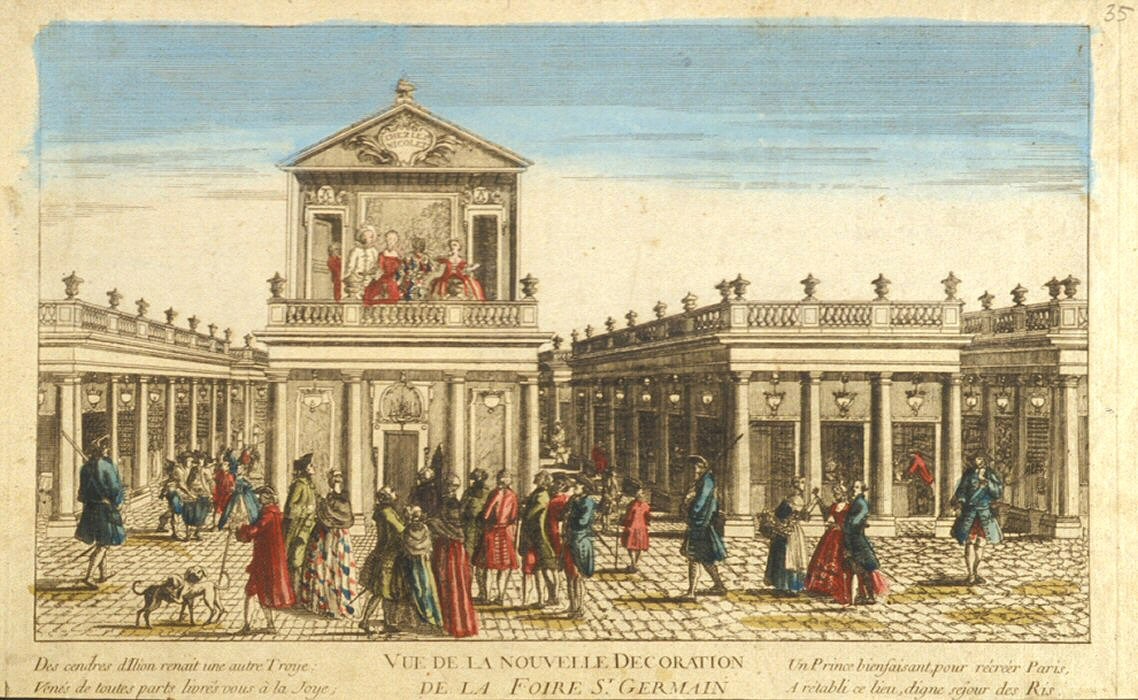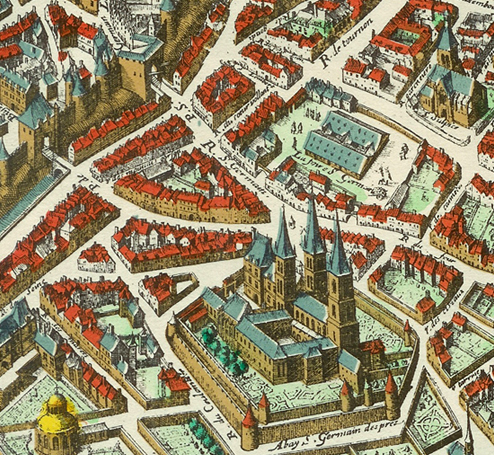|
Parade (French Street Entertainment)
A ''parade'' is a type of French street entertainment which originated during the Renaissance. It consisted of a group of entertainers, which could include actors, singers, dancers, jugglers, and other types of performers, who took part in parades (in the usual sense of the word) and entertained spectators at those times when the procession stopped moving.Bartlet, M. Elizabeth C., "Parade" in Sadie 1992, vol. 3, p. 850. In the 18th century the term was applied to short improvisational buffooneries, typically incorporating vulgarities, which were performed either on an outdoor platform or a balcony in order to entice passersby into show-booths and theatres at the fairs or on the Boulevard du Temple. The characters were often drawn from the '' commedia dell'arte'' tradition. According to Elizabeth Bartlet "the humour was of the crudest sort, relying on sexual innuendos or even explicit remarks and actions, obscene gestures and references to defecation and other bodily functions." ... [...More Info...] [...Related Items...] OR: [Wikipedia] [Google] [Baidu] |
Renaissance
The Renaissance ( , ) , from , with the same meanings. is a period in European history The history of Europe is traditionally divided into four time periods: prehistoric Europe (prior to about 800 BC), classical antiquity (800 BC to AD 500), the Middle Ages (AD 500 to AD 1500), and the modern era (since AD 1500). The first early ... marking the transition from the Middle Ages to modernity and covering the 15th and 16th centuries, characterized by an effort to revive and surpass ideas and achievements of classical antiquity. It occurred after the Crisis of the Late Middle Ages and was associated with great social change. In addition to the standard periodization, proponents of a "long Renaissance" may put its beginning in the 14th century and its end in the 17th century. The traditional view focuses more on the Early modern period, early modern aspects of the Renaissance and argues that it was a break from the past, but many historians today focus more on its medieval a ... [...More Info...] [...Related Items...] OR: [Wikipedia] [Google] [Baidu] |
Parade
A parade is a procession of people, usually organized along a street, often in costume, and often accompanied by marching bands, floats, or sometimes large balloons. Parades are held for a wide range of reasons, but are usually celebrations of some kind. In British English, the term "parade" is usually reserved for either military parades or other occasions where participants march in formation; for celebratory occasions, the word procession is more usual. The term "parade" may also be used for multiple different subjects; for example, in the Canadian Armed Forces, "parade" is used both to describe the procession and in other informal connotations. Protest demonstrations can also take the form of a parade, but such cases are usually referred to as a march instead. Parade float The parade float got its name because the first floats were decorated barges that were towed along the canals with ropes held by parade marchers on the shore. Floats were occasionally propelled from ... [...More Info...] [...Related Items...] OR: [Wikipedia] [Google] [Baidu] |
Théâtre De La Foire
Théâtre de la foire is the collective name given to the theatre put on at the annual fairs at Saint-Germain and Saint-Laurent (and for a time, at Saint-Ovide) in Paris. Foire Saint-Germain The earliest references to the annual fair date to 1176. The fairground itself was established in 1482 by Louis XI for the benefit of the Abbey of Saint-Germain-des-Prés and was located near the Abbey on the Left Bank southwest of the city center just outside one of the gates of the city wall built by Philip II at the beginning of the 13th century. The covered Saint-Germain market today occupies part of the former fairground site with access from the Boulevard Saint-Germain via the Rue de Montfaucon satellite view. The fair generally lasted three to five weeks around Easter. During the 18th century it consistently opened on 3 February and lasted until Palm Sunday. The fair's first actors whose names are recorded were Jehan Courtin and Nicolas Poteau, who so entertained the Parisian public ... [...More Info...] [...Related Items...] OR: [Wikipedia] [Google] [Baidu] |
Boulevard Du Temple
The Boulevard du Temple, formerly nicknamed the "Boulevard du Crime", is a thoroughfare in Paris that separates the 3rd arrondissement from the 11th. It runs from the Place de la République to the Place Pasdeloup, and its name refers to the nearby Knights Templars' Temple where they established their Paris priory. History The Boulevard du Temple follows the path of the city wall constructed by Charles V (the so-called ''Enceinte'', constructed between 1356 and 1383) and demolished under Louis XIV. The boulevard, lined with trees, was built between 1656 and 1705. From the time of Louis XVI (1774–1792) until the July Monarchy in 1830, the Boulevard du Temple was popular and fashionable. It was a place for walking and recreation. Cafés and theatres previously located at the Saint-Laurent and Saint-Germain fairs moved here. After a time, it was nicknamed the ''Boulevard du Crime'' after the crime melodramas that were so popular in its many theatres. In 1782, Philippe Curti ... [...More Info...] [...Related Items...] OR: [Wikipedia] [Google] [Baidu] |
Commedia Dell'arte
(; ; ) was an early form of professional theatre, originating from Italian theatre, that was popular throughout Europe between the 16th and 18th centuries. It was formerly called Italian comedy in English and is also known as , , and . Characterized by masked "types", was responsible for the rise of actresses such as Isabella Andreini and improvised performances based on sketches or scenarios. A , such as ''The Tooth Puller'', is both scripted and improvised. Characters' entrances and exits are scripted. A special characteristic of is the , a joke or "something foolish or witty", usually well known to the performers and to some extent a scripted routine. Another characteristic of is pantomime, which is mostly used by the character Arlecchino, now better known as Harlequin. The characters of the usually represent fixed social types and stock characters, such as foolish old men, devious servants, or military officers full of false bravado. The characters are exaggerated "r ... [...More Info...] [...Related Items...] OR: [Wikipedia] [Google] [Baidu] |
Elisabeth Bartlet (musicologist)
Mary Elizabeth Caroline Bartlet (1948 – 11 September 2005) was a Canadian-born musicologist known for her scholarship on French music, and particularly opera, in the 18th and 19th centuries. She also produced pioneering critical editions of the scores for Rossini's ''Guillaume Tell'' and Rameau's ''Platée''. At the time of her death she was a professor of music at Duke University and a director of the American Musicological Society. Life and career Bartlet was born in Renfrew, Ontario, to Mary Elizabeth ''née ''Dingle and John Coburn Bartlet. She received her BA and MA in Music from the University of Toronto in 1970 and 1972 respectively and began her career as an oboist. She later pursued graduate studies in musicology at the University of Chicago under Philip Gossett. She received her PhD from Chicago in 1982 with a doctoral dissertation on the French composer Étienne Méhul entitled ''Etienne Nicolas Méhul and opera during the French Revolution, Consulate, and Empire: a ... [...More Info...] [...Related Items...] OR: [Wikipedia] [Google] [Baidu] |
Opéra-comique
The Opéra-Comique is a Paris opera company which was founded around 1714 by some of the popular theatres of the Parisian fairs. In 1762 the company was merged with – and for a time took the name of – its chief rival, the Comédie-Italienne at the Hôtel de Bourgogne. It was also called the Théâtre-Italien up to about 1793, when it again became most commonly known as the Opéra-Comique. Today the company's official name is Théâtre national de l'Opéra-Comique, and its theatre, with a capacity of around 1,248 seats, sometimes referred to as the Salle Favart (the third on this site), is located at Place Boïeldieu in the 2nd arrondissement of Paris, not far from the Palais Garnier, one of the theatres of the Paris Opéra. The musicians and others associated with the Opéra-Comique have made important contributions to operatic history and tradition in France and to French opera. Its current mission is to reconnect with its history and discover its unique repertoire to en ... [...More Info...] [...Related Items...] OR: [Wikipedia] [Google] [Baidu] |
Boulevard du Temple
The Boulevard du Temple, formerly nicknamed the "Boulevard du Crime", is a thoroughfare in Paris that separates the 3rd arrondissement from the 11th. It runs from the Place de la République to the Place Pasdeloup, and its name refers to the nearby Knights Templars' Temple, where they established their Paris priory. History The Boulevard du Temple follows the path of the city wall constructed by Charles V (the so-called ''Enceinte'', constructed between 1356 and 1383) and demolished under Louis XIV. The boulevard, lined with trees, was built between 1656 and 1705. From the time of Louis XVI (1774–1792) until the July Monarchy in 1830, the Boulevard du Temple was popular and fashionable. It was a place for walking and recreation. Cafés and theatres previously located at the Saint-Laurent and Saint-Germain fairs moved here. After a time, it was nicknamed the ''Boulevard du Crime'' after the crime melodramas that were so popular in its many theatres. In 1782, Philippe Cu ... [...More Info...] [...Related Items...] OR: [Wikipedia] [Google] [Baidu] |
Sadie, Stanley
Stanley John Sadie (; 30 October 1930 – 21 March 2005) was an influential and prolific British musicologist, music critic, and editor. He was editor of the sixth edition of the '' Grove Dictionary of Music and Musicians'' (1980), which was published as the first edition of ''The New Grove Dictionary of Music and Musicians''. Along with Thurston Dart, Nigel Fortune and Oliver Neighbour he was one of Britain's leading musicologists of the post-World War II generation. Career Born in Wembley, Sadie was educated at St Paul's School, London, and studied music privately for three years with Bernard Stevens. At Gonville and Caius College, Cambridge he read music under Thurston Dart. Sadie earned Bachelor of Arts and Bachelor of Music degrees in 1953, a Master of Arts degree in 1957, and a PhD in 1958. His doctoral dissertation was on mid-eighteenth-century British chamber music. After Cambridge, he taught at Trinity College of Music, London (1957–1965). Sadie then turned to mu ... [...More Info...] [...Related Items...] OR: [Wikipedia] [Google] [Baidu] |
The New Grove Dictionary Of Opera
''The New Grove Dictionary of Opera'' is an encyclopedia of opera, considered to be one of the best general reference sources on the subject. It is the largest work on opera in English, and in its printed form, amounts to 5,448 pages in four volumes. First published in 1992 by Macmillan Reference, London, it was edited by Stanley Sadie with contributions from over 1,300 scholars. There are 11,000 articles in total, covering over 2,900 composers and 1800 operas. Appendices including an index of role names and an index of incipits of arias, ensembles, and opera pieces. The dictionary is available online, together with ''The New Grove Dictionary of Music and Musicians''. References *William Salaman, "Review: The New Grove Dictionary of Opera", ''British Journal of Music Education'' (1999), 16: 97-110 Cambridge University Pres*John Simon, "Review: The New Grove Dictionary of Opera, 4 vols.", ''National Review'', April 26, 199* * *Charles Rosen, "Review: The New Grove Dictionary of ... [...More Info...] [...Related Items...] OR: [Wikipedia] [Google] [Baidu] |




.jpg)

